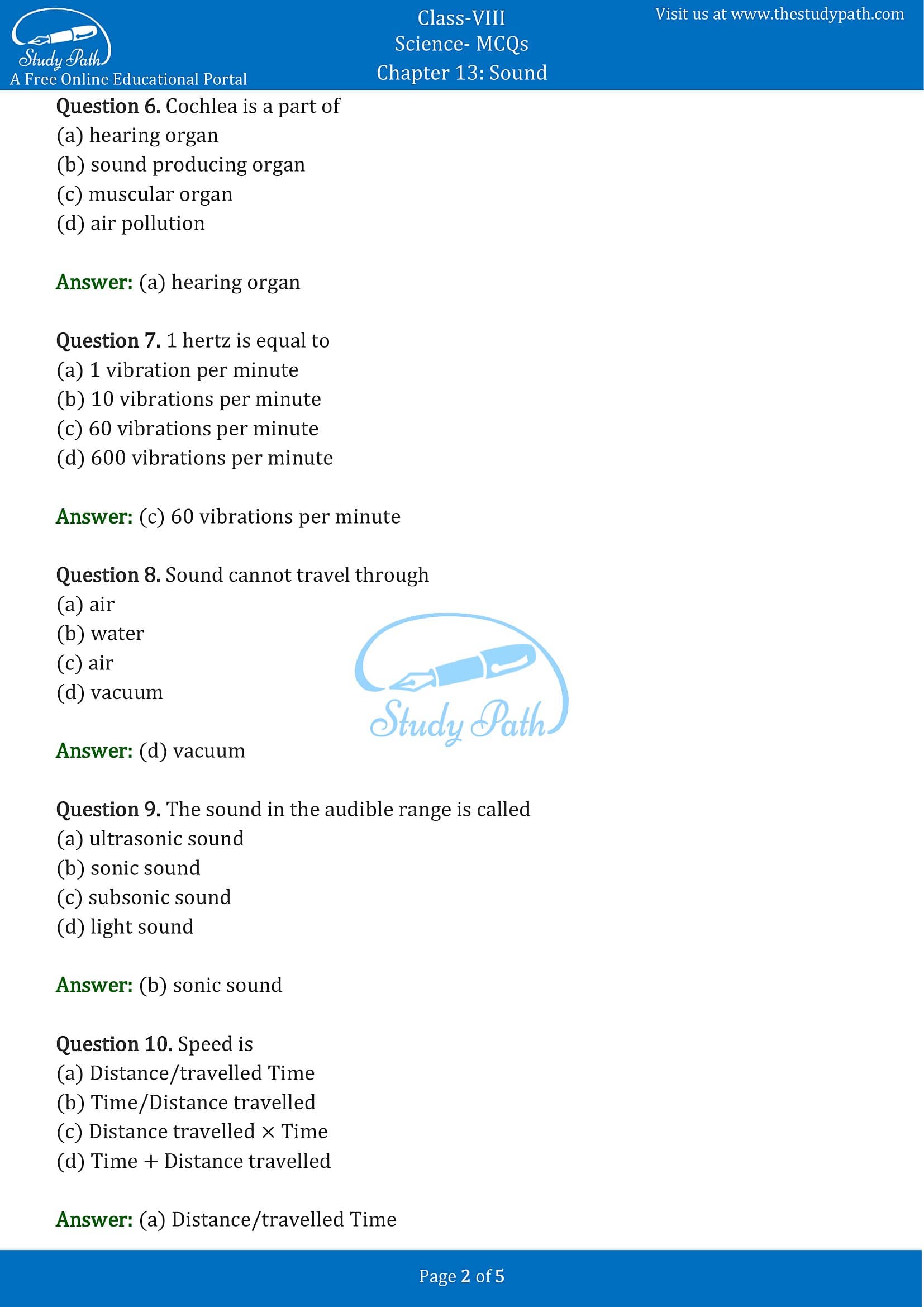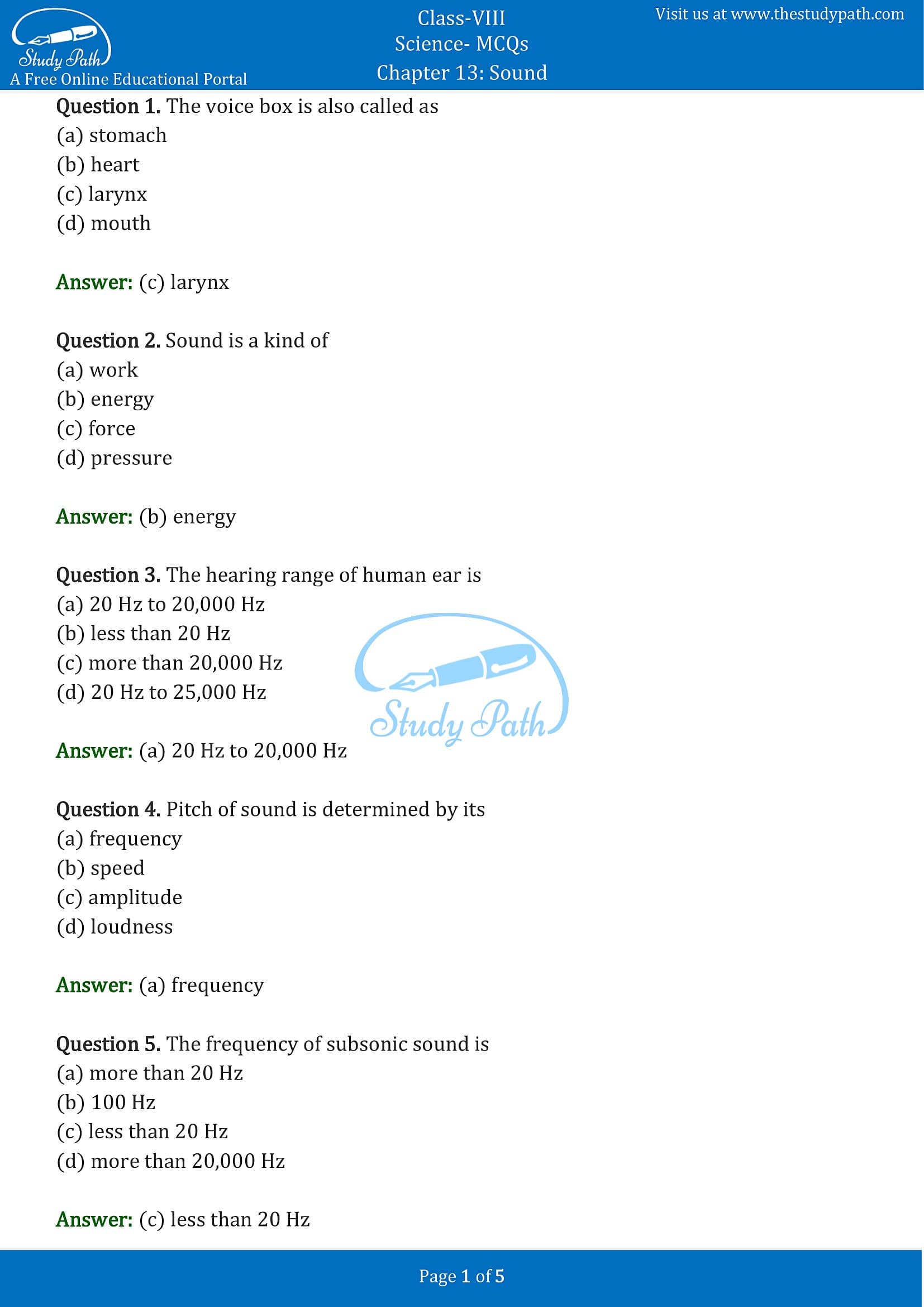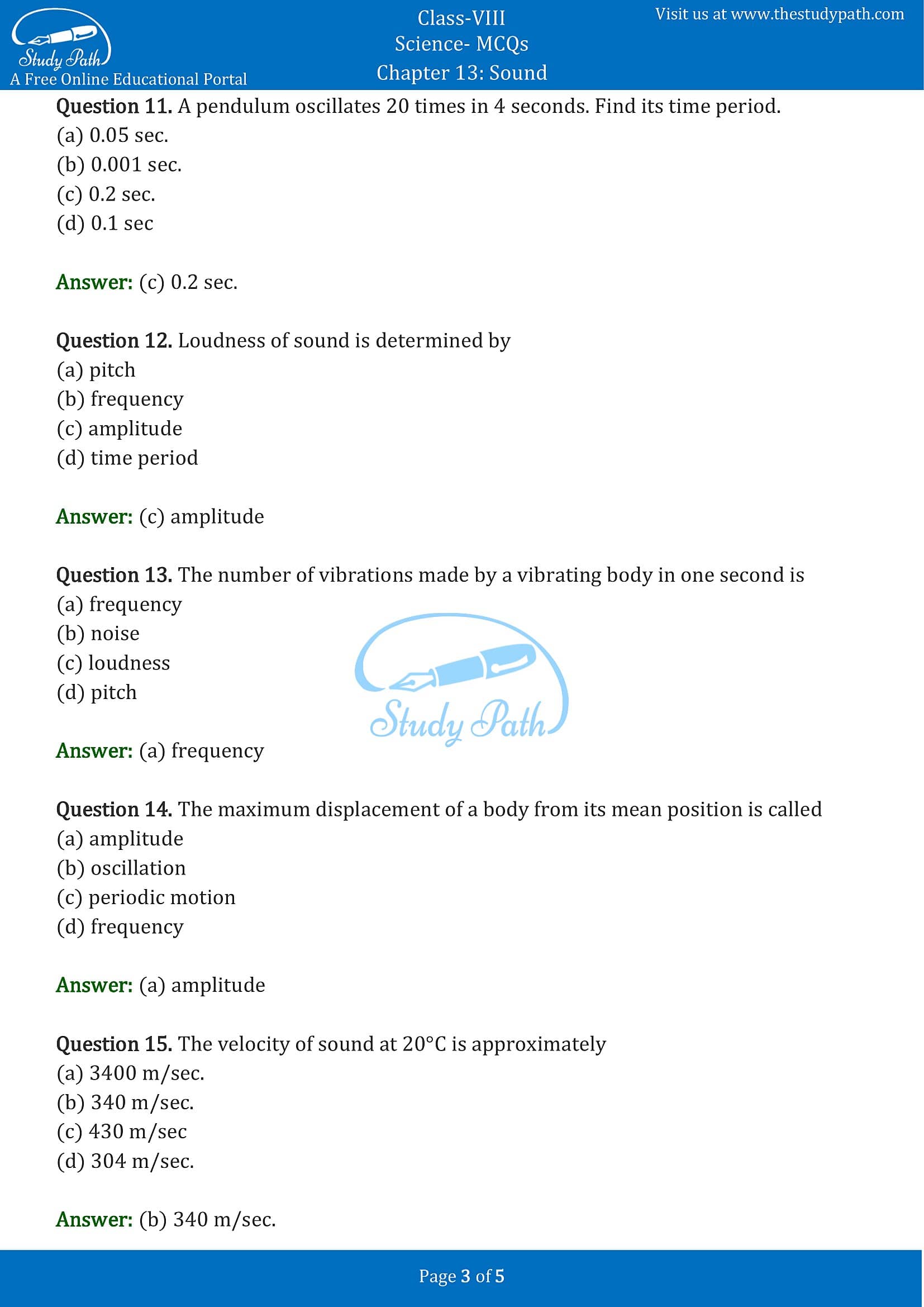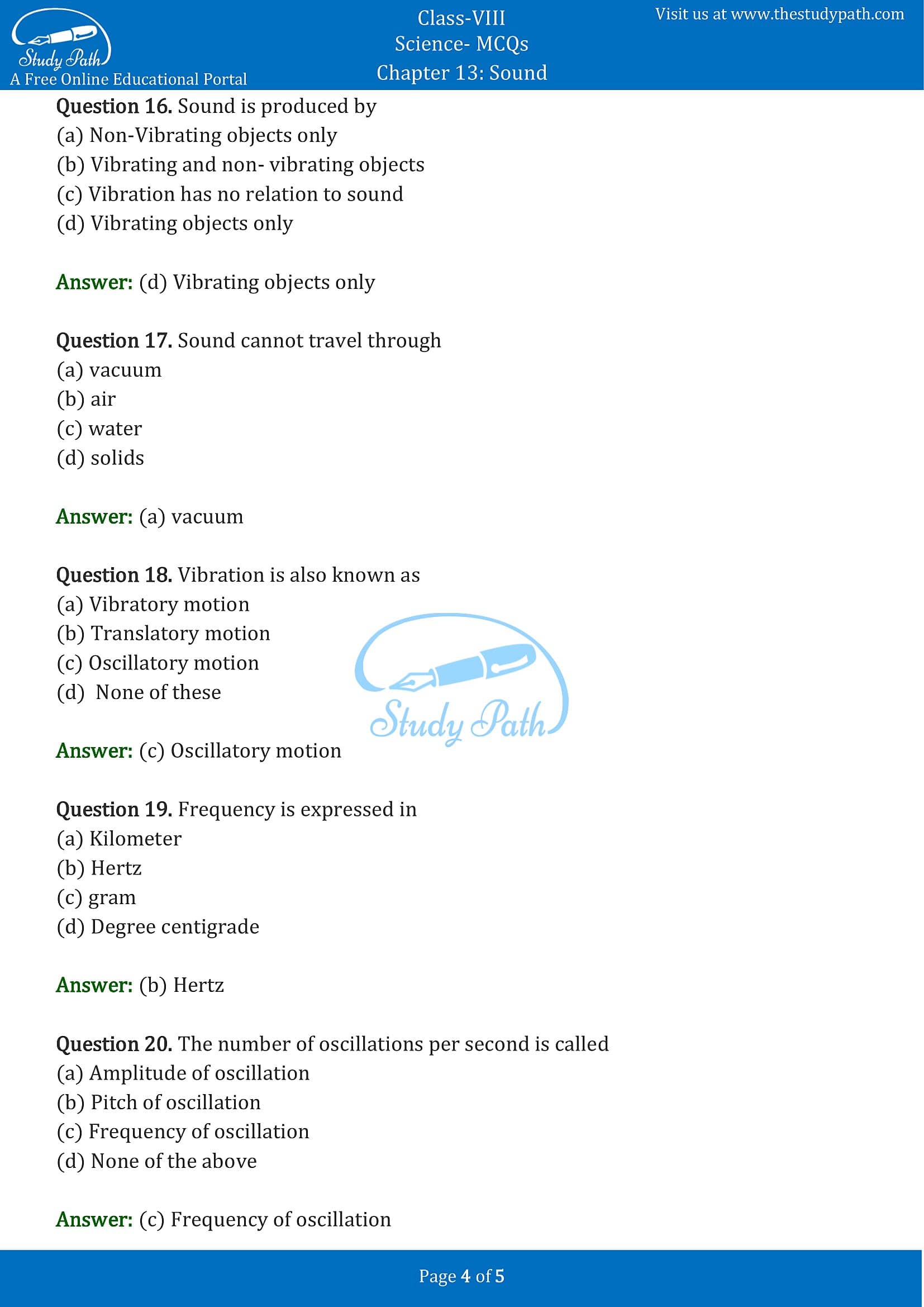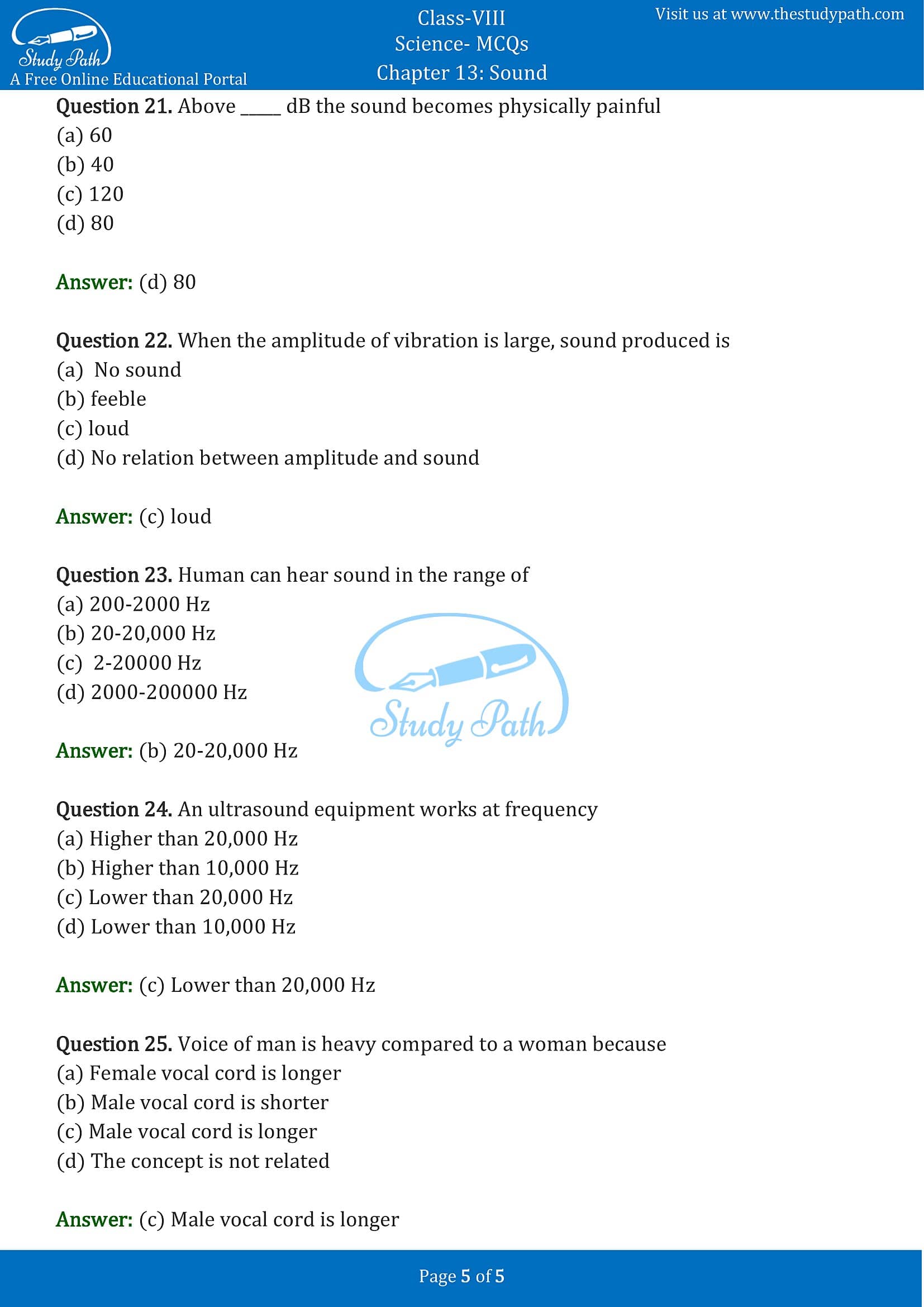Class 8 Science Chapter 13 Sound MCQ with Answers
Class 8 Science Chapter 13 Sound MCQ (Multiple Choice Questions) with Answers is available here in PDF format. CBSE Class 8 Science Sound Objective Questions helps the students to understand the concepts thoroughly and to score good marks. Practising these MCQs will help you to answer every question that is being asked in the exams.
At Study Path, you can download PDF of Multiple Choice Questions for Class 8 Chapter 13 Sound with Answers. We prepared these MCQs on the basis latest exam Pattern. Students can solve NCERT Class 8 Science Sound MCQs before the exam to know their preparation level.
Sound Class 8 MCQ with Answers PDF
Multiple Choice Questions (MCQs)
Question 1. The voice box is also called as
(a) stomach
(b) heart
(c) larynx
(d) mouth
Answer: (c) larynx
Question 2. Sound is a kind of
(a) work
(b) energy
(c) force
(d) pressure
Answer: (b) energy
Question 3. The hearing range of human ear is
(a) 20 Hz to 20,000 Hz
(b) less than 20 Hz
(c) more than 20,000 Hz
(d) 20 Hz to 25,000 Hz
Answer: (a) 20 Hz to 20,000 Hz
Question 4. Pitch of sound is determined by its
(a) frequency
(b) speed
(c) amplitude
(d) loudness
Answer: (a) frequency
Question 5. The frequency of subsonic sound is
(a) more than 20 Hz
(b) 100 Hz
(c) less than 20 Hz
(d) more than 20,000 Hz
Answer: (c) less than 20 Hz
Question 6. Cochlea is a part of
(a) hearing organ
(b) sound producing organ
(c) muscular organ
(d) air pollution
Answer: (a) hearing organ
Question 7. 1 hertz is equal to
(a) 1 vibration per minute
(b) 10 vibrations per minute
(c) 60 vibrations per minute
(d) 600 vibrations per minute
Answer: (c) 60 vibrations per minute
Question 8. Sound cannot travel through
(a) air
(b) water
(c) air
(d) vacuum
Answer: (d) vacuum
Question 9. The sound in the audible range is called
(a) ultrasonic sound
(b) sonic sound
(c) subsonic sound
(d) light sound
Answer: (b) sonic sound
Question 10. Speed is
(a) Distance/travelled Time
(b) Time/Distance travelled
(c) Distance travelled × Time
(d) Time + Distance travelled
Answer: (a) Distance/travelled Time
Question 11. A pendulum oscillates 20 times in 4 seconds. Find its time period.
(a) 0.05 sec.
(b) 0.001 sec.
(c) 0.2 sec.
(d) 0.1 sec
Answer: (c) 0.2 sec.
Question 12. Loudness of sound is determined by
(a) pitch
(b) frequency
(c) amplitude
(d) time period
Answer: (c) amplitude
Question 13. The number of vibrations made by a vibrating body in one second is
(a) frequency
(b) noise
(c) loudness
(d) pitch
Answer: (a) frequency
Question 14. The maximum displacement of a body from its mean position is called
(a) amplitude
(b) oscillation
(c) periodic motion
(d) frequency
Answer: (a) amplitude
Question 15. The velocity of sound at 20°C is approximately
(a) 3400 m/sec.
(b) 340 m/sec.
(c) 430 m/sec
(d) 304 m/sec.
Answer: (b) 340 m/sec.
Question 16. Sound is produced by
(a) Non-Vibrating objects only
(b) Vibrating and non- vibrating objects
(c) Vibration has no relation to sound
(d) Vibrating objects only
Answer: (d) Vibrating objects only
Question 17. Sound cannot travel through
(a) vacuum
(b) air
(c) water
(d) solids
Answer: (a) vacuum
Question 18. Vibration is also known as
(a) Vibratory motion
(b) Translatory motion
(c) Oscillatory motion
(d) None of these
Answer: (c) Oscillatory motion
Question 19. Frequency is expressed in
(a) Kilometer
(b) Hertz
(c) gram
(d) Degree centigrade
Answer: (b) Hertz
Question 20. The number of oscillations per second is called
(a) Amplitude of oscillation
(b) Pitch of oscillation
(c) Frequency of oscillation
(d) None of the above
Answer: (c) Frequency of oscillation
Question 21. Above _____ dB the sound becomes physically painful
(a) 60
(b) 40
(c) 120
(d) 80
Answer: (d) 80
Question 22. When the amplitude of vibration is large, sound produced is
(a) No sound
(b) feeble
(c) loud
(d) No relation between amplitude and sound
Answer: (c) loud
Question 23. Human can hear sound in the range of
(a) 200-2000 Hz
(b) 20-20,000 Hz
(c) 2-20000 Hz
(d) 2000-200000 Hz
Answer: (b) 20-20,000 Hz
Question 24. An ultrasound equipment works at frequency
(a) Higher than 20,000 Hz
(b) Higher than 10,000 Hz
(c) Lower than 20,000 Hz
(d) Lower than 10,000 Hz
Answer: (c) Lower than 20,000 Hz
Question 25. Voice of man is heavy compared to a woman because
(a) Female vocal cord is longer
(b) Male vocal cord is shorter
(c) Male vocal cord is longer
(d) The concept is not related
Answer: (c) Male vocal cord is longer
At Study Path, you can also learn more about science chapter 13 sound by accessing the free exhaustive list of study materials and resources related to the chapter such as NCERT Solutions, Important Questions and Extra Questions.
